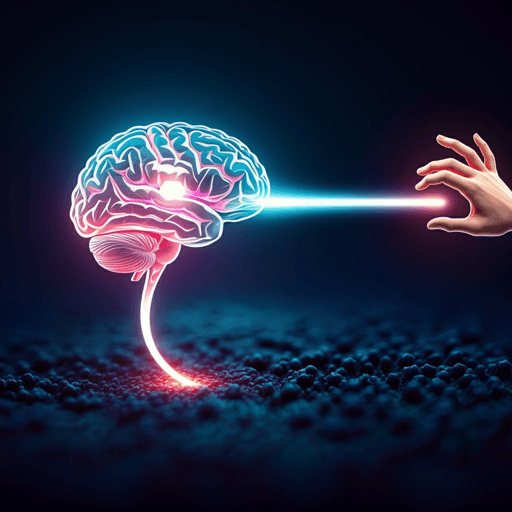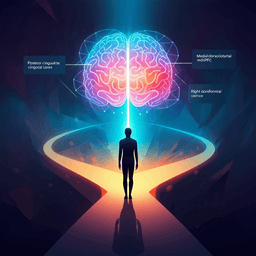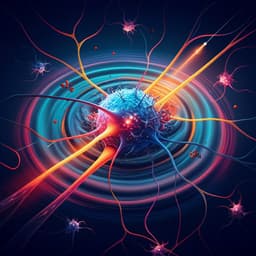
Medicine and Health
Neuronal responses in the human primary motor cortex coincide with the subjective onset of movement intention in brain-machine interface-mediated actions
J. Noel, M. Bockbrader, et al.
Using a unique BMI-NMES setup in a tetraplegic participant, this study shows that motor intentions create a perceived temporal attraction between intention and action, and that human M1 spiking activity aligns with the onset of subjective intention. This research was conducted by Authors present in <Authors> tag.
~3 min • Beginner • English
Introduction
The study investigates how neural activity in human primary motor cortex (M1) relates to the subjective experience of intending to move and its temporal relationship to action and environmental effects. Prior paradigms (Libet task, intentional binding) have suggested that intention precedes action and that voluntary actions compress perceived time between actions and their effects, implicating frontoparietal circuits (ACC, SMA/pre-SMA, posterior parietal). However, the full intentional chain (intention→action→effect) has not been examined with invasive recordings in humans, and the timing relation between subjective intention and neural activity in M1 remains unknown. The research leverages a tetraplegic BMI user with NMES that can selectively include or bypass intention, action, or effect, allowing precise measurement of subjective timing and neural responses to test whether M1 activity coincides with, precedes, or follows the subjective onset of intention.
Literature Review
Foundational work using electrical stimulation of frontal and parietal cortex elicits an 'urge to move', suggesting early generation of intention signals (Fried 1991; Desmurget et al. 2009). Single-neuron recordings in medial frontal areas (pre-SMA/SMA/ACC) show neural activity anticipating reported intention by ~0.7–1.5 s (Fried et al. 2011), consistent with preparatory dynamics (readiness potential) and accumulating evidence models (Schurger et al. 2012, 2016). The Libet task examines intention timing but omits environmental consequences; intentional binding demonstrates action-effect compression without directly measuring intention (Haggard 2002; 2008). Motor preparatory networks include ACC, SMA/pre-SMA, and parietal cortex (Sirigu et al. 2004; Tanji & Evarts 1976; Kubota & Funahashi 1982; Haggard 2017). M1 is the final cortical output node and a common BMI target, yet its role in subjective intention timing is underexplored. Evidence accumulation and movement-null vs movement-potent subspaces may explain how preparatory signals do not immediately cause movement (Kaufman et al. 2014; Elsayed et al. 2016; Khilkevich et al. 2024). Prior BMI studies demonstrate decoding of intention and control of movement from motor and parietal areas (Aflalo et al. 2015; Bouton et al. 2016; Ajiboye et al. 2017; Collinger et al. 2013; Hochberg et al. 2006, 2012; Wandelt et al. 2022).
Methodology
Participant: A 27-year-old male with stable C5/C6 tetraplegia (motor complete at C5, zone of partial preservation to C6) and >5 years of BMI use. He retained shoulder/elbow movements and proprioception in upper limb; impaired proprioception in digits. Ethics approvals: FDA IDE and OSU IRB; consent obtained; trial registered (NCT01997125).
Surgical procedures and recording: Implantation of a 96-channel Utah microelectrode array in the dominant hand region of left M1, targeted via pre-operative fMRI hand imagery and intraoperative navigation. Neural data sampled at 30 kHz; hardware band-pass 0.3 Hz–7.5 kHz; NMES artifacts removed by 3.5 ms blanking when >500 µV in ≥4 of 12 randomly selected channels.
Movement decoder (BMI): Non-linear SVM using mean wavelet power (MWP) features from wavelet scales 3–6 (multi-unit band ~235 Hz–3.75 kHz) computed in 100 ms bins across 96 channels. Two decoders trained (hand opening HO vs rest; hand closing HC vs rest) using animated virtual hand imagery, seven blocks (five repetitions per movement) per session (~10 min). Output normalized to −1 to 1; movement threshold at zero-crossing; NMES triggered on threshold crossing. During experiments, HC was operant (linked to tone).
Neuromuscular electrical stimulation (NMES): Multi-channel stimulator with 130-electrode forearm sleeve (12 mm electrodes, 22 mm longitudinal × 15 mm transverse spacing), monophasic rectangular pulses at 50 Hz (500 µs pulse width, 0–20 mA). Per-session calibration (~5–10 min) established electrode patterns and intensities for desired movements.
Experimental design: Across 12 sessions (~35 hours total), participant viewed a 2,560 ms revolution clock (ticks 0–60); initial hand position randomized. After each trial, he reported the perceived timing (clock position) of a single element: intention (I), action (A), or tone effect (E). Five experiments (50 repetitions per report/condition unless noted): (1) Baseline: random NMES-evoked HC (no intention) or random tone (no action), assessing temporal perception absent causal structure. (2) Full intentional chain: intention→HC→tone (300 ms after movement/decoder threshold); reports of I, A, or E. (3) No effect: intention→HC without tone; reports of I or A. (4) No intention: NMES-evoked HC→tone with no intention; reports of A or E. (5) No action: intention→decoder threshold→tone but NMES disabled; reports of I or E. Report type varied in mini-runs of 5 trials; experiments intermixed across sessions.
Data processing and analyses: Single-unit sorting via WaveClust after 300 Hz–30 kHz filtering; manual validation; spikes binned at 1 ms. Multi-unit activity (MUA) obtained by Gaussian convolution (σ=50 ms) and averaging across trials; evoked onset defined as ≥5 SD above baseline. Alignments to action onset (or decoder threshold time for no-action trials) and to subjective report times. Confidence in timing relations assessed via random temporal perturbations of reports (uniform ±10 to ±1000 ms) and degradation threshold (≥10 time points differ at p<0.01). Population dynamics via PCA of average firing rates (first two PCs; 81.9% variance); Euclidean distances over time; bootstrapped 1,000 resamples for 95% CIs. LFP power via wavelet decomposition (0.5–30 Hz); SVM (10-fold CV) classification of induced vs baseline power in sliding windows to quantify separability when intention/action/effect is absent. Decoder time course analyzed per condition; statistics with time-resolved unpaired t-tests (Bonferroni corrected). Trial-by-trial single-unit dynamics modeled with logistic (sigmoidal) fits to firing rates approaching reported intention time, extracting baseline/asymptote (f_b, f_i), center (t_0), and steepness (α); trials retained with r²>0.5.
Key Findings
Behavioral temporal binding:
- Overall timing bias: actions and effects perceived ~450–500 ms earlier than objective time (action: −455 ± 21 ms; effect: −512 ± 17 ms). Despite bias, relative A–E interval was accurate and precise (median perceived difference = 257 ms vs objective 300 ms; S.E.M = 17 ms). Variance higher for intention reports (S.E.M = 37.2 ms) than action (21.4 ms) or effect (17.2 ms).
- Full chain (I→A→E): intention perceived to precede action by 71 ms; effect follows action by 314 ms (error from objective A–E timing: 14 ms).
- Removing intention (NMES-evoked HC): actions perceived later (with intention: −526 ± 44 ms vs without intention: −355 ± 18 ms; p = 9.09×10⁻⁵).
- Removing action (decoder threshold→tone): intentions perceived earlier (with action: −597 ± 79 ms vs without action: −796 ± 129 ms; p = 0.02). Effect timing unchanged in these manipulations (all p > 0.1).
- Removing effect: no change in perceived timing of intention (p = 0.41) or action (p = 0.07).
Conclusion: Novel intentional binding between intention and action, showing compression of subjective timing.
Neural M1 responses:
- MUA intention-only trials: robust evoked activity peaking ~5–8 Hz ~338 ms before movement onset.
- MUA movement-only trials: evoked peak ~20 Hz ~373 ms after movement onset. No MUA responses to tones.
- Aligning to subjective times: evoked MUA onset occurs ~14 ms after reported intention time; ~7 ms after reported action time. Evoked responses resistant to temporal perturbations up to ~±120 ms.
- Decoder-defined 'objective' intention (first surpassing 5 SD above noise) precedes action by ~70 ms on average, but MUA aligned better with subjective intention than this objective threshold.
Population dynamics and LFP:
- PCA trajectories bifurcate based on presence of intention; Euclidean distance grows prior to movement, peaks ~300 ms post-onset.
- Trials with early vs late perceived intention show separable trajectories from −1360 to −360 ms relative to movement.
- LFP power: intention reflected in sustained delta (0.5–4 Hz), and intermittently in theta (4–8 Hz) and alpha (8–13 Hz); differences between conditions with vs without intention detectable as early as −1.09 s (delta), −0.98 s (theta), and −0.87 s (alpha), peaking −290 ms (delta) and −210 ms (theta) relative to movement; alpha peaks at movement onset. Movement decoding strongest in alpha/beta, ~330 ms post-onset.
Single-unit trial-by-trial correlations:
- 8/66 neurons (12%) show spike-count correlations with reported intention timing in the 1 s window before movement (all p < 0.05). 1/66 correlates with action timing (r = −0.62, p = 0.01). None with effect timing.
- Sigmoidal fits (r²>0.5; n=177 trials): firing rate increases on average 108 ms prior to reported intention; changes are more step-like in M1 (mean α ≈ 23) than frontal areas reported previously (mean α ≈ 54).
Decoder dynamics and binding:
- Decoder output bifurcates 1,100 ms prior to movement between intended vs non-intended actions (p < 0.01). Without action, decoder drops earlier (~+100 ms; p < 0.01). Without effect, decoder remains sustained longer (~+500 ms; p < 0.01).
- AUC-based sorting: higher AUC trials show intention perceived later (closer to action; p = 3.77×10⁻⁴) and action perceived earlier (closer to intention; p = 0.01), consistent with intention–action binding. Effect timing not modulated by AUC (p = 0.22).
Discussion
The unique BMI–NMES setup enabled selective manipulation of intention, action, and effect while recording M1 activity and collecting subjective timing reports, revealing a novel intentional binding between intention and action. M1 shows dissociable signals for intention and action, and crucially, evoked spiking activity in human M1 largely co-occurs (±~120 ms) with the subjective onset of intention, unlike pre-SMA/SMA/ACC where neural activity precedes intention by ~700–1,500 ms. This suggests that while preparatory signals exist upstream, the subjective experience of intention may coincide with a reformatting of neural dynamics into a movement-potent subspace in M1 near movement initiation. Population-level measures (PCA, LFP, decoder) indicate intention-related dynamics can be detected up to ~1 s before movement, but their strongest association with subjective intention occurs closer to movement onset. Trial-by-trial single-unit correlations and sigmoidal fits support that a subset of M1 neurons track when the urge to move is experienced. These findings bridge a key gap by relating M1 spiking directly to subjective intention and emphasize the importance of considering both linear (MUA) and multivariate (population) dynamics when interpreting intentional processes.
Conclusion
This study identifies a new form of temporal binding between perceived intention and action, and demonstrates that M1 evoked spiking largely coincides with the subjective onset of intention, with some neurons predicting trial-to-trial fluctuations in intention timing. Population dynamics in M1 reflect intention earlier but are less tightly coupled to subjective onset than MUA, and decoder performance captures intention–action binding. The work closes a critical gap in understanding the temporal relationship between M1 neural activity and subjective intention in humans. Future research should test generalizability in neurotypical participants using non-invasive BMIs, perform causal perturbations with concurrent recordings to assess on-/off-manifold effects, and integrate multisite recordings (ACC, SMA/pre-SMA, premotor, parietal) across participants to map the intentional chain comprehensively.
Limitations
Findings derive from a single tetraplegic, expert BMI user who likely exhibits neuroplasticity and sensorimotor recalibration, including a large bias in temporal perception, which may limit generalizability. The study is correlational; causal roles of M1 in intention were not tested. Subjective timing reports inherently contain uncertainty (e.g., perception of clock position, internal criteria for intention onset). Recordings were restricted to M1 due to clinical constraints; key intentional network nodes (ACC, SMA/pre-SMA, premotor, parietal) were not simultaneously recorded. Some effects (e.g., intention–action binding) may be amplified by BMI-mediated control and thus require replication in broader populations.
Related Publications
Explore these studies to deepen your understanding of the subject.







